fuel cap BMW ACTIVEHYBRID X6 2010 Owners Manual
[x] Cancel search | Manufacturer: BMW, Model Year: 2010, Model line: ACTIVEHYBRID X6, Model: BMW ACTIVEHYBRID X6 2010Pages: 54, PDF Size: 3.16 MB
Page 24 of 54
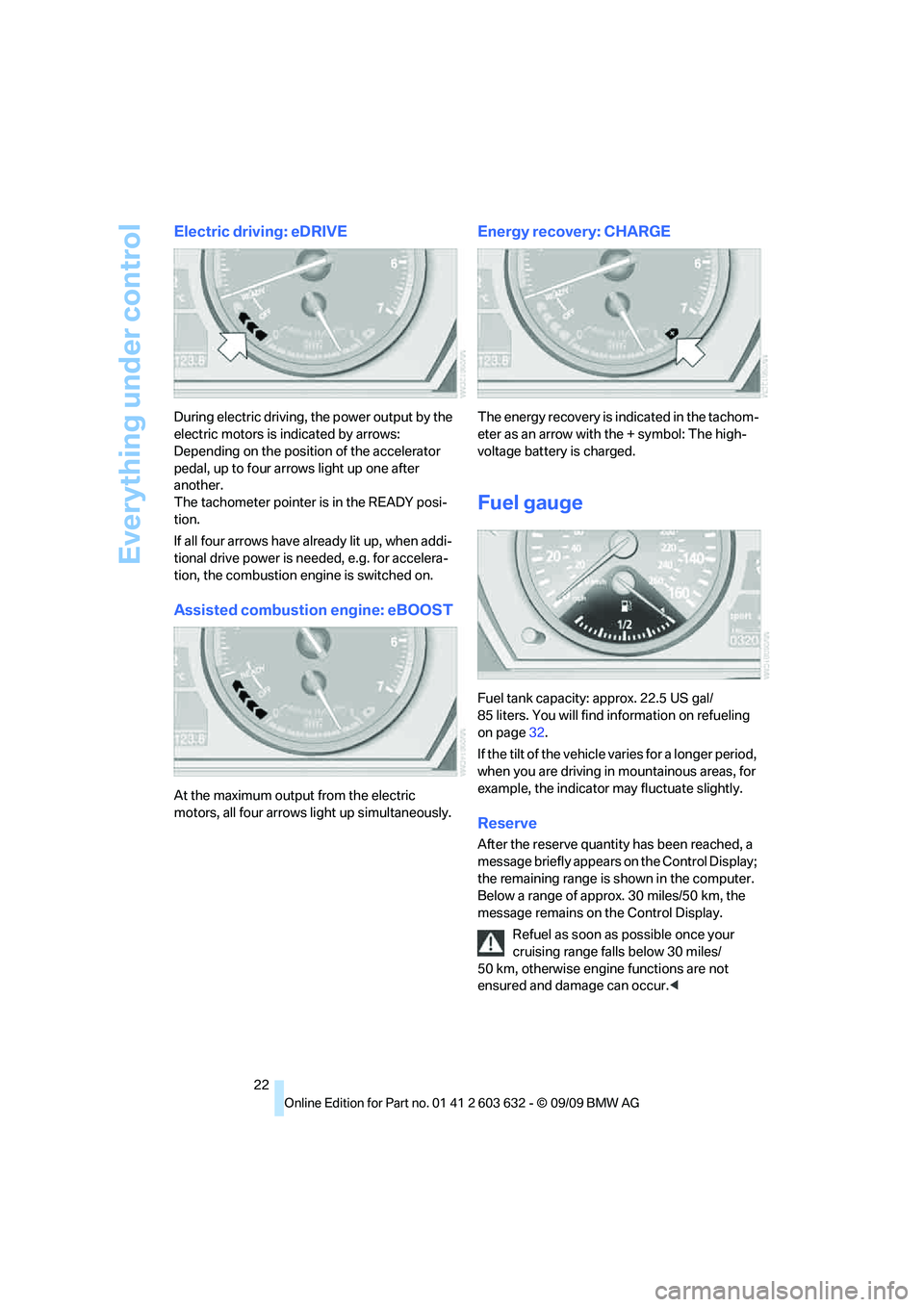
Everything under control
22
Electric driving: eDRIVE
During electric driving, the power output by the
electric motors is indicated by arrows:
Depending on the position of the accelerator
pedal, up to four arrows light up one after
another.
The tachometer pointer is in the READY posi-
tion.
If all four arrows have already lit up, when addi-
tional drive power is needed, e.g. for accelera-
tion, the combustion engine is switched on.
Assisted combustion engine: eBOOST
At the maximum output from the electric
motors, all four arrows light up simultaneously.
Energy recovery: CHARGE
The energy recovery is indicated in the tachom-
eter as an arrow with the + symbol: The high-
voltage battery is charged.
Fuel gauge
Fuel tank capacity: approx. 22.5 US gal/
85 liters. You will find information on refueling
on page32.
If the tilt of the vehicle varies for a longer period,
when you are driving in mountainous areas, for
example, the indicator may fluctuate slightly.
Reserve
After the reserve quantity has been reached, a
message briefly appears on the Control Display;
the remaining range is shown in the computer.
Below a range of approx. 30 miles/50 km, the
message remains on the Control Display.
Refuel as soon as possible once your
cruising range falls below 30 miles/
50 km, otherwise engine functions are not
ensured and damage can occur.<
Page 34 of 54
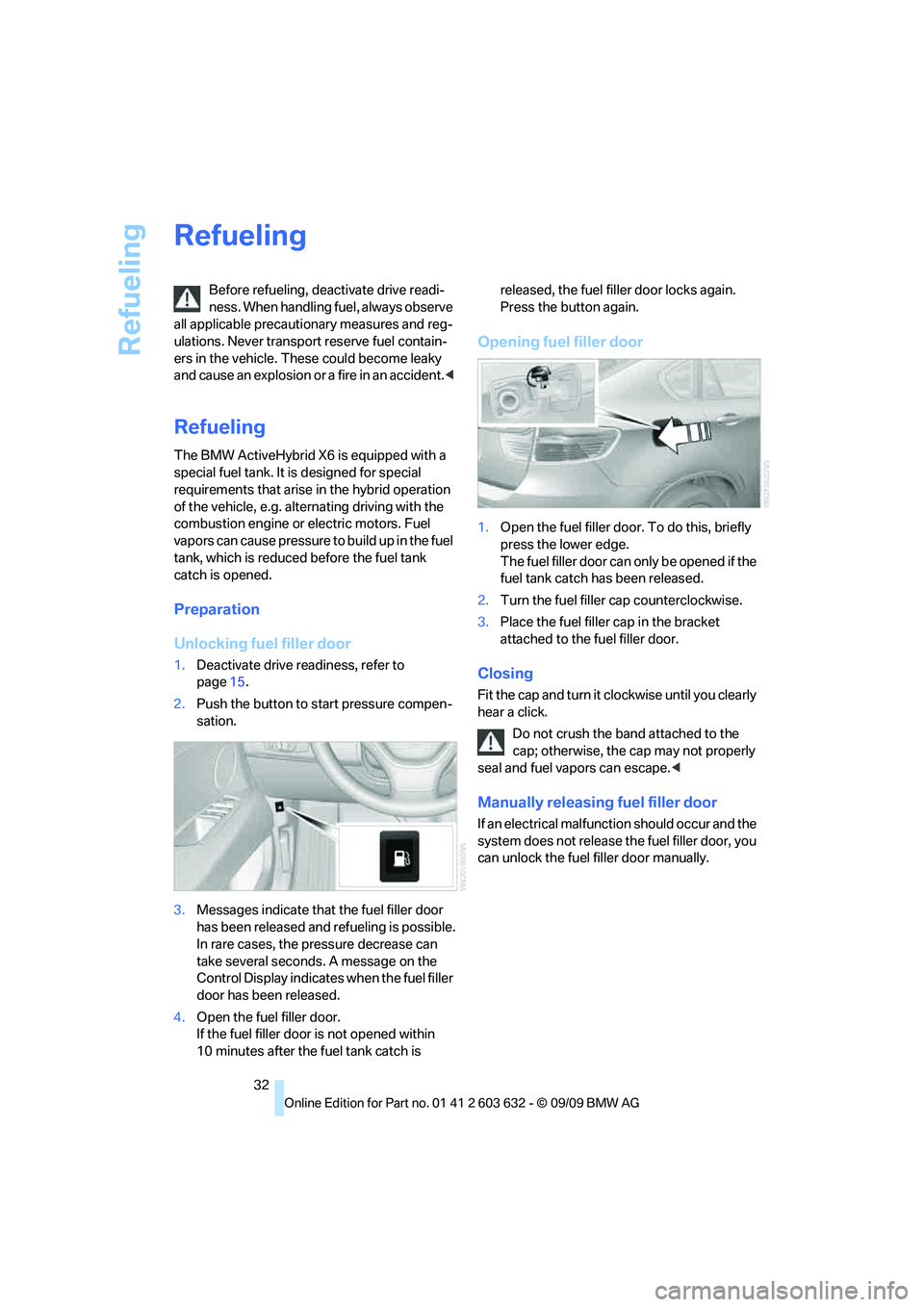
Refueling
32
Refueling
Before refueling, deactivate drive readi-
ness. When handling fuel, always observe
all applicable precautionary measures and reg-
ulations. Never transport reserve fuel contain-
ers in the vehicle. These could become leaky
and cause an explosion or a fire in an accident.<
Refueling
The BMW ActiveHybrid X6 is equipped with a
special fuel tank. It is designed for special
requirements that arise in the hybrid operation
of the vehicle, e.g. alternating driving with the
combustion engine or electric motors. Fuel
vapors can cause pressure to build up in the fuel
tank, which is reduced before the fuel tank
catch is opened.
Preparation
Unlocking fuel filler door
1.Deactivate drive readiness, refer to
page15.
2.Push the button to start pressure compen-
sation.
3.Messages indicate that the fuel filler door
has been released and refueling is possible.
In rare cases, the pressure decrease can
take several seconds. A message on the
Control Display indicates when the fuel filler
door has been released.
4.Open the fuel filler door.
If the fuel filler door is not opened within
10 minutes after the fuel tank catch is released, the fuel filler door locks again.
Press the button again.
Opening fuel filler door
1.Open the fuel filler door. To do this, briefly
press the lower edge.
The fuel filler door can only be opened if the
fuel tank catch has been released.
2.Turn the fuel filler cap counterclockwise.
3.Place the fuel filler cap in the bracket
attached to the fuel filler door.
Closing
Fit the cap and turn it clockwise until you clearly
hear a click.
Do not crush the band attached to the
cap; otherwise, the cap may not properly
seal and fuel vapors can escape.<
Manually releasing fuel filler door
If an electrical malfunction should occur and the
system does not release the fuel filler door, you
can unlock the fuel filler door manually.
Page 35 of 54
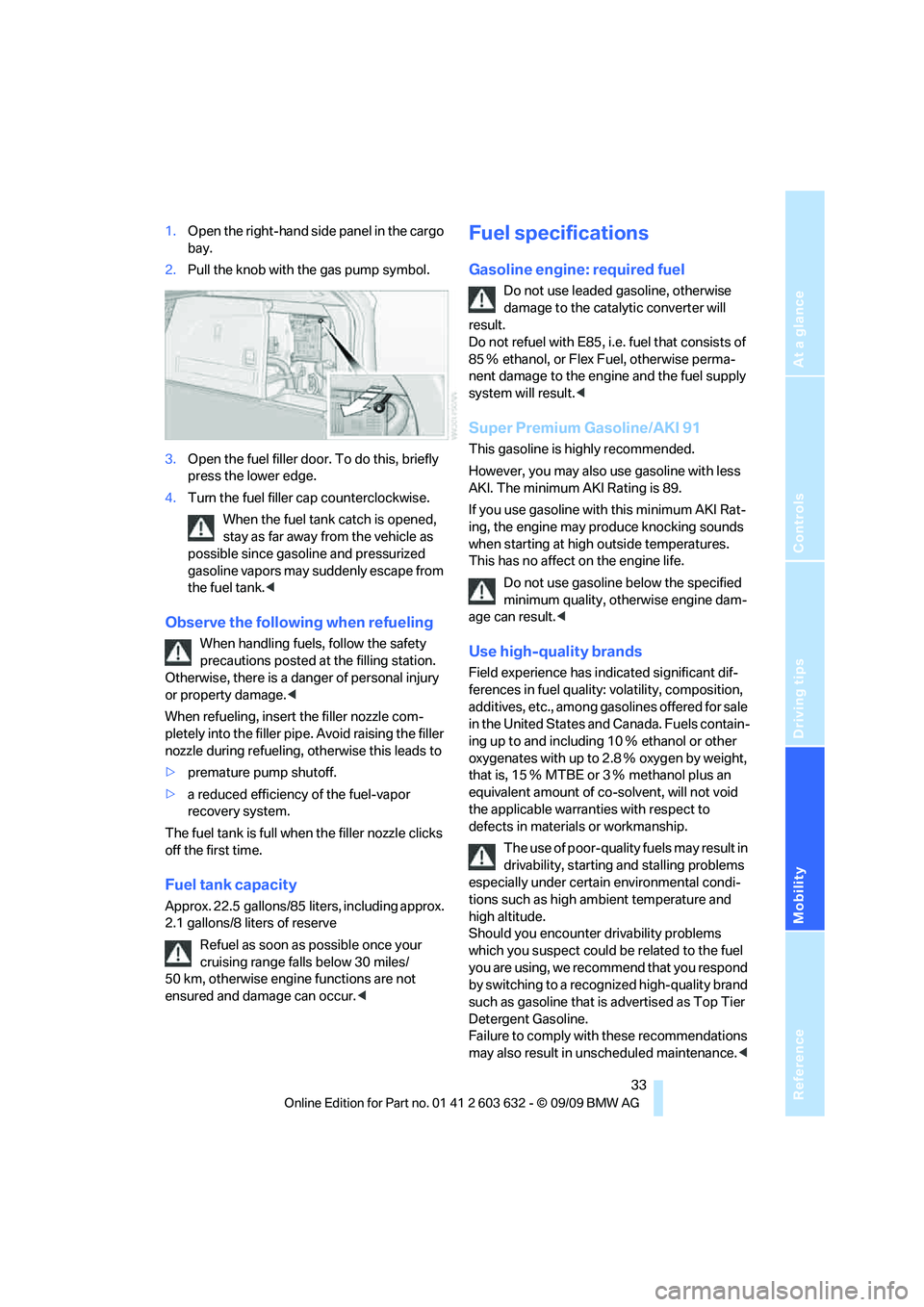
Reference
At a glance
Controls
Driving tips
Mobility
33
1.Open the right-hand side panel in the cargo
bay.
2.Pull the knob with the gas pump symbol.
3.Open the fuel filler door. To do this, briefly
press the lower edge.
4.Turn the fuel filler cap counterclockwise.
When the fuel tank catch is opened,
stay as far away from the vehicle as
possible since gasoline and pressurized
gasoline vapors may suddenly escape from
the fuel tank.<
Observe the following when refueling
When handling fuels, follow the safety
precautions posted at the filling station.
Otherwise, there is a danger of personal injury
or property damage.<
When refueling, insert the filler nozzle com-
pletely into the filler pipe. Avoid raising the filler
nozzle during refueling, otherwise this leads to
>premature pump shutoff.
>a reduced efficiency of the fuel-vapor
recovery system.
The fuel tank is full when the filler nozzle clicks
off the first time.
Fuel tank capacity
Approx. 22.5 gallons/85 liters, including approx.
2.1 gallons/8 liters of reserve
Refuel as soon as possible once your
cruising range falls below 30 miles/
50 km, otherwise engine functions are not
ensured and damage can occur.<
Fuel specifications
Gasoline engine: required fuel
Do not use leaded gasoline, otherwise
damage to the catalytic converter will
result.
Do not refuel with E85, i.e. fuel that consists of
85% ethanol, or Flex Fuel, otherwise perma-
nent damage to the engine and the fuel supply
system will result.<
Super Premium Gasoline/AKI 91
This gasoline is highly recommended.
However, you may also use gasoline with less
AKI. The minimum AKI Rating is 89.
If you use gasoline with this minimum AKI Rat-
ing, the engine may produce knocking sounds
when starting at high outside temperatures.
This has no affect on the engine life.
Do not use gasoline below the specified
minimum quality, otherwise engine dam-
age can result.<
Use high-quality brands
Field experience has indicated significant dif-
ferences in fuel quality: volatility, composition,
additives, etc., among gasolines offered for sale
in the United States and Canada. Fuels contain-
ing up to and including 10% ethanol or other
oxygenates with up to 2.8% oxygen by weight,
that is, 15% MTBE or 3% methanol plus an
equivalent amount of co-solvent, will not void
the applicable warranties with respect to
defects in materials or workmanship.
The use of poor-quality fuels may result in
drivability, starting and stalling problems
especially under certain environmental condi-
tions such as high ambient temperature and
high altitude.
Should you encounter drivability problems
which you suspect could be related to the fuel
you are using, we recommend that you respond
by switching to a recognized high-quality brand
such as gasoline that is advertised as Top Tier
Detergent Gasoline.
Failure to comply with these recommendations
may also result in unscheduled maintenance.<
Page 48 of 54
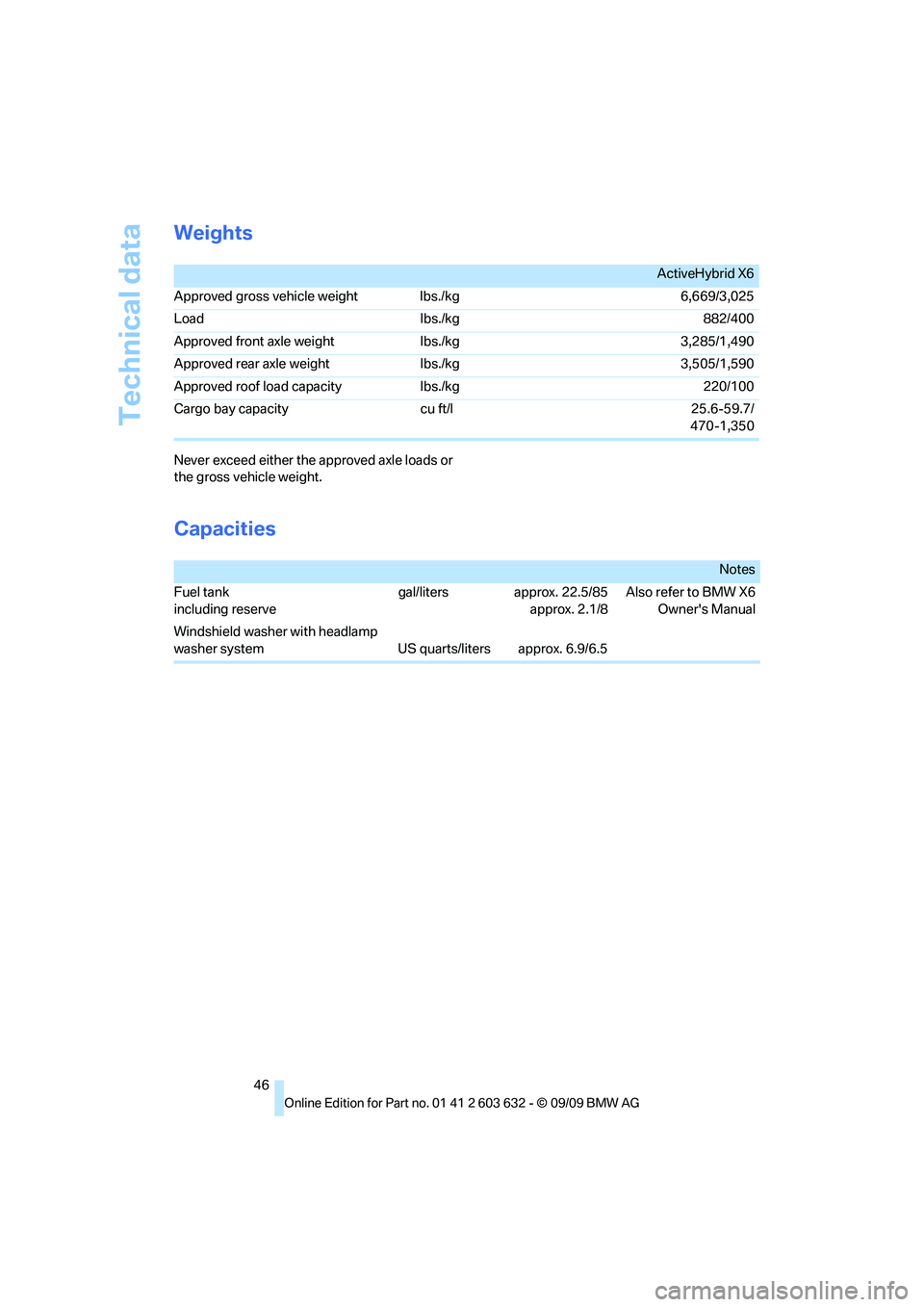
Technical data
46
Weights
Never exceed either the approved axle loads or
the gross vehicle weight.
Capacities
ActiveHybrid X6
Approved gross vehicle weight Ibs./kg 6,669/3,025
Load Ibs./kg 882/400
Approved front axle weight Ibs./kg 3,285/1,490
Approved rear axle weight Ibs./kg 3,505/1,590
Approved roof load capacity Ibs./kg 220/100
Cargo bay capacity cu ft/l 25.6-59.7/
470-1,350
Notes
Fuel tank
including reservegal/liters approx. 22.5/85
approx. 2.1/8Also refer to BMW X6
Owner's Manual
Windshield washer with headlamp
washer system US quarts/liters approx. 6.9/6.5
Page 50 of 54
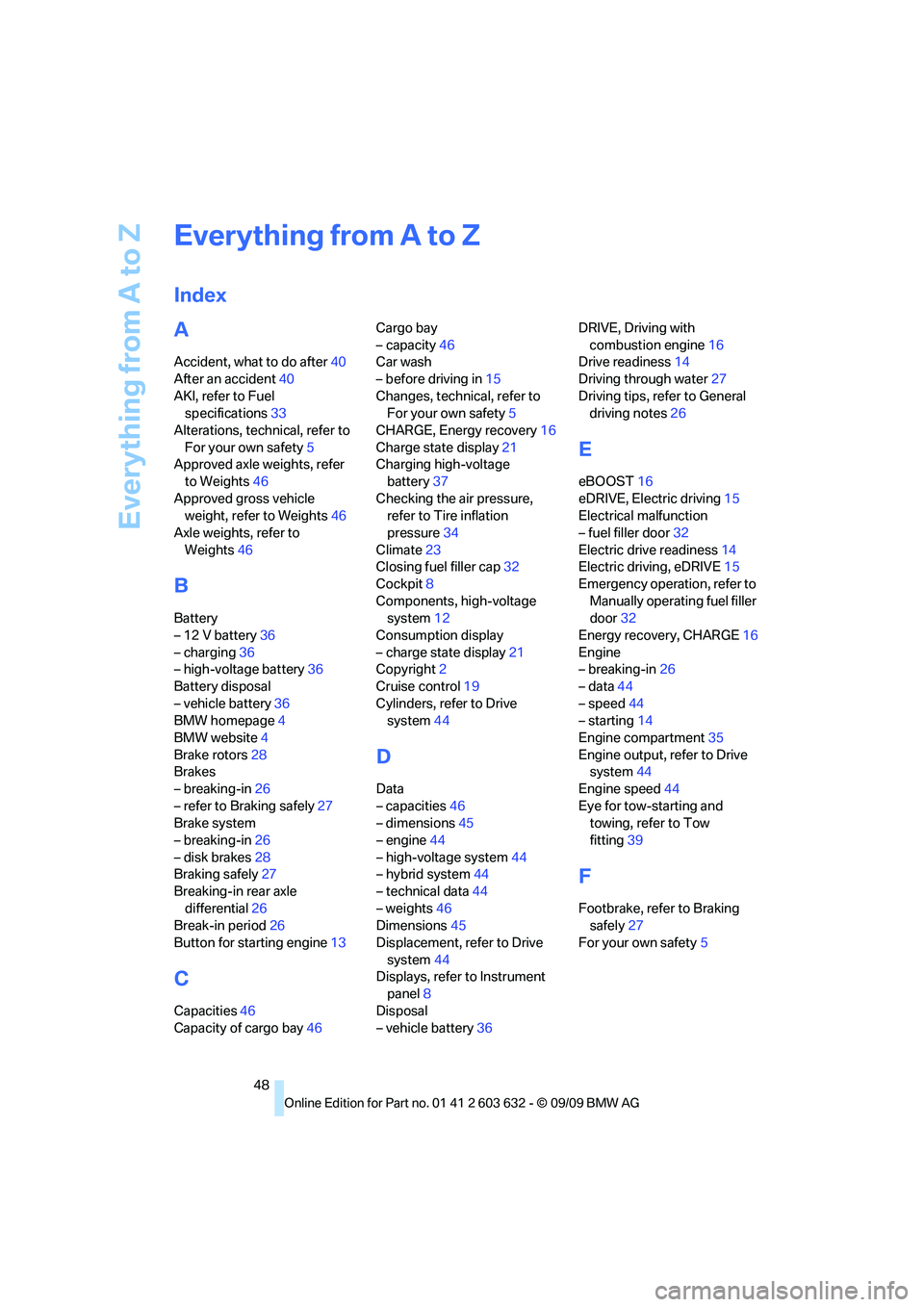
Everything from A to Z
48
Everything from A to Z
Index
A
Accident, what to do after40
After an accident40
AKI, refer to Fuel
specifications33
Alterations, technical, refer to
For your own safety5
Approved axle weights, refer
to Weights46
Approved gross vehicle
weight, refer to Weights46
Axle weights, refer to
Weights46
B
Battery
– 12 V battery36
– charging36
– high-voltage battery36
Battery disposal
– vehicle battery36
BMW homepage4
BMW website4
Brake rotors28
Brakes
– breaking-in26
– refer to Braking safely27
Brake system
– breaking-in26
– disk brakes28
Braking safely27
Breaking-in rear axle
differential26
Break-in period26
Button for starting engine13
C
Capacities46
Capacity of cargo bay46Cargo bay
– capacity46
Car wash
– before driving in15
Changes, technical, refer to
For your own safety5
CHARGE, Energy recovery16
Charge state display21
Charging high-voltage
battery37
Checking the air pressure,
refer to Tire inflation
pressure34
Climate23
Closing fuel filler cap32
Cockpit8
Components, high-voltage
system12
Consumption display
– charge state display21
Copyright2
Cruise control19
Cylinders, refer to Drive
system44
D
Data
– capacities46
– dimensions45
– engine44
– high-voltage system44
– hybrid system44
– technical data44
– weights46
Dimensions45
Displacement, refer to Drive
system44
Displays, refer to Instrument
panel8
Disposal
– vehicle battery36DRIVE, Driving with
combustion engine16
Drive readiness14
Driving through water27
Driving tips, refer to General
driving notes26
E
eBOOST16
eDRIVE, Electric driving15
Electrical malfunction
– fuel filler door32
Electric drive readiness14
Electric driving, eDRIVE15
Emergency operation, refer to
Manually operating fuel filler
door32
Energy recovery, CHARGE16
Engine
– breaking-in26
– data44
– speed44
– starting14
Engine compartment35
Engine output, refer to Drive
system44
Engine speed44
Eye for tow-starting and
towing, refer to Tow
fitting39
F
Footbrake, refer to Braking
safely27
For your own safety5
Page 51 of 54
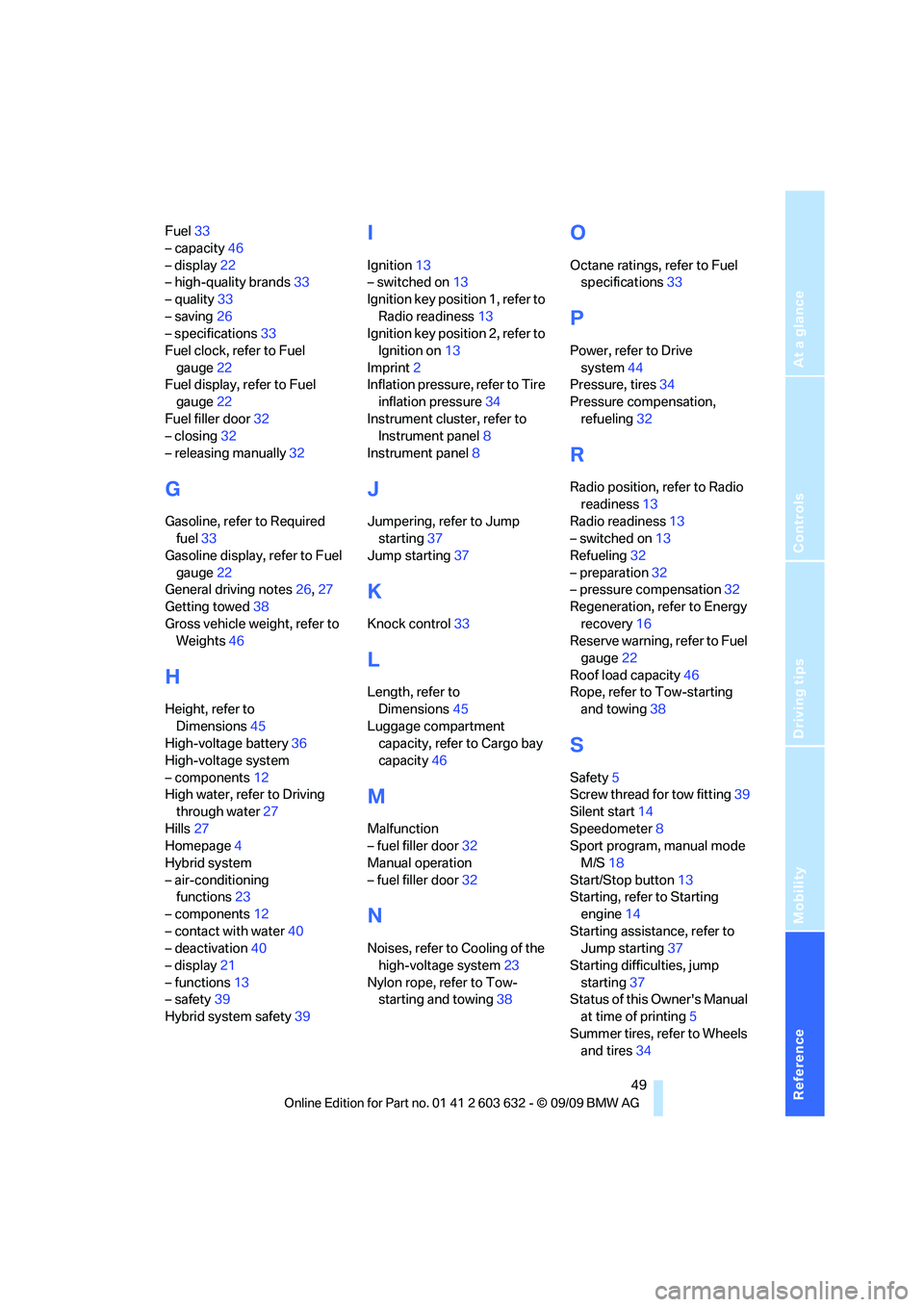
Reference
At a glance
Controls
Driving tips
Mobility
49
Fuel33
– capacity46
– display22
– high-quality brands33
– quality33
– saving26
– specifications33
Fuel clock, refer to Fuel
gauge22
Fuel display, refer to Fuel
gauge22
Fuel filler door32
– closing32
– releasing manually32
G
Gasoline, refer to Required
fuel33
Gasoline display, refer to Fuel
gauge22
General driving notes26,27
Getting towed38
Gross vehicle weight, refer to
Weights46
H
Height, refer to
Dimensions45
High-voltage battery36
High-voltage system
– components12
High water, refer to Driving
through water27
Hills27
Homepage4
Hybrid system
– air-conditioning
functions23
– components12
– contact with water40
– deactivation40
– display21
– functions13
– safety39
Hybrid system safety39
I
Ignition13
– switched on13
Ignition key position 1, refer to
Radio readiness13
Ignition key position 2, refer to
Ignition on13
Imprint2
Inflation pressure, refer to Tire
inflation pressure34
Instrument cluster, refer to
Instrument panel8
Instrument panel8
J
Jumpering, refer to Jump
starting37
Jump starting37
K
Knock control33
L
Length, refer to
Dimensions45
Luggage compartment
capacity, refer to Cargo bay
capacity46
M
Malfunction
– fuel filler door32
Manual operation
– fuel filler door32
N
Noises, refer to Cooling of the
high-voltage system23
Nylon rope, refer to Tow-
starting and towing38
O
Octane ratings, refer to Fuel
specifications33
P
Power, refer to Drive
system44
Pressure, tires34
Pressure compensation,
refueling32
R
Radio position, refer to Radio
readiness13
Radio readiness13
– switched on13
Refueling32
– preparation32
– pressure compensation32
Regeneration, refer to Energy
recovery16
Reserve warning, refer to Fuel
gauge22
Roof load capacity46
Rope, refer to Tow-starting
and towing38
S
Safety5
Screw thread for tow fitting39
Silent start14
Speedometer8
Sport program, manual mode
M/S18
Start/Stop button13
Starting, refer to Starting
engine14
Starting assistance, refer to
Jump starting37
Starting difficulties, jump
starting37
Status of this Owner's Manual
at time of printing5
Summer tires, refer to Wheels
and tires34